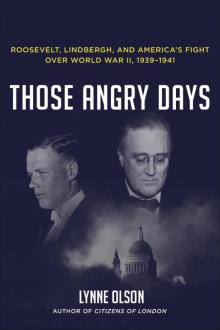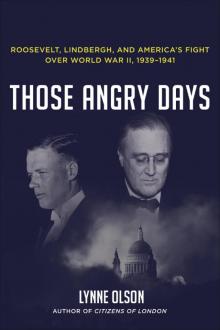- Home
- Lynne Olson
Madame Fourcade's Secret War
Madame Fourcade's Secret War Read online
Copyright © 2019 by Lynne Olson
All rights reserved.
Published in the United States by Random House, an imprint and division of Penguin Random House LLC, New York.
RANDOM HOUSE and the HOUSE colophon are registered trademarks of Penguin Random House LLC.
PHOTO CREDITS: This page: Assemblée-Nationale; this page, this page, this page, this page: Chemins de Mémoire; this page, this page, this page: Compagnons de la Libèration; this page: Les Français Libres; this page: National Portrait Gallery (UK); this page, this page, this page: Alamy; this page: Musée de la Reddition; this page, this page, this page, this page: Patrick Rodriguez-Redington; this page: Fondation de la France Libre; this page: Yad Vashem; this page: Rev. Jerome Bertram; this page, this page: Creative Commons; this page, this page: Dorie Denbigh-Laurent; this page: Collection Résistance et Mémoire; this page: Des Isnards family; this page, this page: Granger.
LIBRARY OF CONGRESS CATALOGING-IN-PUBLICATION DATA
Names: Olson, Lynne, author.
Title: Madame Fourcade’s secret war: the daring young woman who led France’s largest spy network against Hitler / Lynne Olson.
Other titles: Daring young woman who led France’s largest spy network against Hitler
Description: First edition. | New York: Random House, [2019] | Includes bibliographical references and index.
Identifiers: LCCN 2018049180 | ISBN 9780812994766 | ISBN 9780812994773 (ebook)
Subjects: LCSH: Fourcade, Marie-Madeleine, 1909–1989. | World War, 1939–1945—Secret service—France—Biography. | Spies—France—Biography. | Women spies—France—Biography. | Spies—Great Britain—Biography. | Women spies—Great Britain—Biography. | Espionage, British—France—History—20th century. | World War, 1939–1945—Secret service—Great Britain—Biography. | World War, 1939–1945—Underground movements—France. | World War, 1939–1945—Women—France.
Classification: LCC D810.S8 O4765 2019 | DDC 940.54/8644092 [B]—dc23 LC record available at https://lccn.loc.gov/2018049180
Ebook ISBN 9780812994773
randomhousebooks.com
Title-page and part-title-page images from Everett Historical/Shutterstock.com
Book design by Barbara M. Bachman, adapted for ebook
Cover design: Daniel Rembert
Cover illustration images: © akg-images (portrait of Marie-Madeleine Fourcade) and © Getty Images (alleyway)
Maps by M. Roy Cartography
v5.4_r2
ep
Contents
Cover
Title Page
Copyright
Epigraph
Selected Cast of Characters
Author’s Note
Prologue
1936–1942
Chapter 1: Leaping into the Unknown
Chapter 2: The Chaos of Defeat
Chapter 3: Fighting Back
Chapter 4: Spying in Marseille
Chapter 5: The Birth of Alliance
Chapter 6: Danger in Paris
Chapter 7: Taking Command
Chapter 8: A Network in Peril
Chapter 9: The Mailbag
Chapter 10: The Return of Léon Faye
Chapter 11: A Game of Wits
Chapter 12: “An Undisputed Leader”
Chapter 13: Sitting on a Barrel of Gunpowder
Chapter 14: The Traitor
Chapter 15: A General Escapes
Chapter 16: Captured
Chapter 17: Operation Attila
Chapter 18: “Down Go the U-boats”
1943–1944
Chapter 19: On the Run
Chapter 20: The Tinderbox of Lyon
Chapter 21: High Anxiety
Chapter 22: “Here You Are at Last!”
Chapter 23: “The Most Remarkable Girl of Her Generation”
Chapter 24: Pink Heather
Chapter 25: Calamity
Chapter 26: Captives
Chapter 27: The Map
Chapter 28: Going Home
1944–1945
Chapter 29: Caught in the Net
Chapter 30: Liberation and Beyond
Chapter 31: “Hail Mary, Full of Grace”
Chapter 32: The Road to Gethsemane
Epilogue
Dedication
Acknowledgments
Notes
Bibliography
By Lynne Olson
About the Author
They appeared from out of the shadows, and suddenly you felt that you had always known them. The connection formed by a threat to one’s country is the strongest connection of all. People adopt one another, march together. Only capture or death can tear them apart.
—Marie-Madeleine Fourcade
Fact had outpaced fiction in producing the copybook “beautiful spy.” This was Marie-Madeleine.
—Commander Kenneth Cohen, MI6 official in charge of French intelligence operations during World War II
ALLIANCE NETWORK
LEADERS
GEORGES LOUSTAUNAU-LACAU—A former French military intelligence officer and aide to Marshal Philippe Pétain, he founded what would become the Alliance intelligence network in the fall of 1940.
MARIE-MADELEINE (MÉRIC) FOURCADE—Originally Loustaunau-Lacau’s deputy, she took over command of Alliance in July 1941 and led it until the end of the war.
LÉON FAYE—The former deputy chief of the French air force in North Africa, he became Fourcade’s second in command in January 1942.
PAUL BERNARD—A banking executive and old friend of Fourcade’s, who succeeded her as head of Alliance operations when she traveled to London in the summer of 1943.
FIRST WAVE (RECRUITED 1940–1941)
MAURICE COUSTENOBLE—A former air force pilot who was one of Fourcade’s first recruits and became one of her key lieutenants.
HENRI SCHAERRER—A daredevil former naval officer who, along with Coustenoble, was one of Fourcade’s closest deputies in the early days of the network.
JEAN BOUTRON—A survivor of the British attack on the French naval fleet at Mers-el-Kébir in July 1940 and another key figure in Alliance’s initial operations, who took an undercover job as Vichy’s deputy naval attaché in Madrid.
CHARLES BERNIS—Regarded as the leading theoretician of French military intelligence, he coordinated and supervised the flow of information sent by Alliance to the British. He later was the network’s chief in the south of France.
GABRIEL RIVIÈRE—Burly and ebullient, he headed Alliance’s operation in Marseille and ran a fruit and vegetable shop as cover for his clandestine activities.
ÉMILE AUDOLY—A Marseille grain merchant who was in charge of collecting intelligence about cargoes and ship movements in the Mediterranean.
JACQUES BRIDOU—A former Olympic bobsled racer and Fourcade’s brother, he served as Alliance’s first emissary to MI6 in London.
HENRI MOUREN—Chief of the Saint-Nazaire shipyard in Brittany, he provided the network with a detailed map of the important German submarine base there.
ANTOINE HUGON—A garage owner and chief of Alliance’s operations in Brittany, who delivered Mouren’s map of Saint-Nazaire to Fourcade.
LUCIEN VALLET—A yo
ung former army officer who served as the network’s chief radio operator in the first year of its existence.
GAVARNI (FIRST NAME UNKNOWN)—A hot-tempered former air force officer who worked briefly as Fourcade’s chief of staff.
JEAN SAINTENY—One of Alliance’s most skilled and daring agents, he ran its sector in Normandy, which played a major role in the success of D-Day.
SECOND WAVE (RECRUITED 1942–1943)
MONIQUE BONTINCK—Fourcade’s young personal courier and assistant, whose demure appearance was at odds with her bold fearlessness.
FERDINAND RODRIGUEZ—A British radio operator sent to Alliance by MI6, he, along with Bontinck and Faye, was among Fourcade’s closest colleagues and confidants in 1942–43.
ERNEST SIEGRIST—A former Paris policeman who was in charge of Alliance’s security and was also a master forger of identity cards and other documents.
COL. ÉDOUARD KAUFFMANN—A former air force colleague of Léon Faye’s, he was head of Alliance’s sector in the Dordogne.
MAURICE DE MACMAHON, THE DUKE OF MAGENTA—A colorful flying ace and scion of one of France’s most illustrious noble families, who was put in charge of Alliance operations in the country’s occupied zone.
LUCIEN POULARD—An air force pilot recruited by Faye, he served as Faye’s adjutant and then as chief of Alliance’s sector in Brittany.
PIERRE DALLAS—Another air force recruit of Faye’s, he headed Alliance’s Avia unit, which handled the logistics of parachute drops and aircraft ferry service from Britain.
MARGUERITE BROUILLET—A social worker who sheltered Fourcade and other Alliance agents from Vichy and German police and later became a close friend of Fourcade’s and a key Alliance operative herself.
PHILIPPE KOENIGSWERTHER—A former spy for the BCRA, the Free French intelligence agency, who became head of Alliance operations in Bordeaux.
GEORGES LAMARQUE—A brilliant young mathematician, he ran an Alliance subnetwork called the Druids that covered all of France and played a major role in keeping the faltering network alive in the last two years of the war.
JEANNIE ROUSSEAU—One of Lamarque’s Druids, she was responsible for one of the greatest Allied intelligence coups of the war through her collection of information about Germany’s V-1 and V-2 terror weapons.
ROBERT LYNEN—The most celebrated child actor in France in the 1930s, he was recruited by Fourcade as a courier in Alliance’s Marseille headquarters.
JEAN VINZANT—A coal and wood merchant, he oversaw Alliance’s operations in the Corrèze, which included clandestine landings of RAF aircraft to pick up and drop off network agents at an airfield near the town of Ussel.
ANDRÉ COINDEAU—An engineer from Nantes who was in charge of Alliance’s intelligence gathering at the port of Saint-Nazaire later in the war.
JEAN PHILIPPE—A police superintendent in Toulouse who joined Alliance in 1942 while still working for the Vichy government. After the war, he was honored by Yad Vashem for his refusal to round up Jews.
ANNE DE MEREUIL—A reporter for the French fashion magazine Marie-Claire and an old friend of Fourcade’s who hid Fourcade and two members of her staff in her apartment in Lyon.
MARGUERITE BERNE-CHURCHILL—A doctor in Lyon who also offered Fourcade a hiding place there and who later joined the network’s headquarters staff in Paris.
THIRD WAVE (RECRUITED 1943–1944)
ROBERT DOUIN—A sculptor and artist whose hand-drawn map of German gun emplacements and fortifications on the Normandy beaches played a role in the Allied success of D-Day.
JACQUES STOSSKOPF—A naval engineer at the Lorient submarine base who was regarded by his countrymen as a Nazi collaborator but who was in fact providing valuable intelligence about the German U-boats to Alliance and the British.
HELEN DES ISNARDS—A former air force pilot and the scion of a prominent aristocratic family, he headed Alliance’s operations in southeast France.
PIERRE NOAL—A young doctor who served as Fourcade’s deputy when she crossed enemy lines in late 1944 to provide intelligence to the Allies on German troop movements in eastern France.
Marie-Madeleine Fourcade, the main character in this book, was a woman of complexities, one of which was how she chose to refer to herself. Throughout World War II, her surname was Méric, the name of her first husband, from whom she had long been estranged. She took the name Fourcade—the surname of her second husband—after the war and used it when she wrote her memoirs; it is the name by which she is known in France today. To avoid the confusion of going back and forth between the two names, I’ve used Fourcade throughout.
It was the middle of the night.
The air in the barracks detention cell was hot and sultry—typical July weather for the southern French town of Aix-en-Provence. Not surprisingly, the woman lying on the cot was bathed in sweat. But the reason wasn’t just the stifling heat. It was also fear. A few hours earlier, she had been captured by the Gestapo while combing through intelligence reports from her resistance network.
The Germans who had taken her captive knew she was an Allied spy, but they had no idea of her true identity. According to her papers—forged, of course—she was a French housewife named Germaine Pezet. Dour and dowdy, she wore spectacles, was drably dressed, and had lusterless jet-black hair. It was the latest of her many disguises, this one concocted in part by a dentist in London who had made the dental prosthetic that had helped transform her appearance. No outward trace remained of the chic blond Parisienne she’d been before the war—a woman born to privilege and known for her beauty and glamor.
For Marie-Madeleine Fourcade, those prewar years seemed like ancient history. Immediately after the German occupation of France, she’d joined the resistance—part of a “minute elite,” as Kenneth Cohen, a top British intelligence official and close friend of hers, called the comparative handful of French men and women who rose up in 1940 to defy the Nazis.
In 1941, at the age of thirty-one, she became la patronne—the boss—of what would emerge as the largest and most important Allied intelligence network in occupied France. Throughout the war, it supplied the British and American high commands with vital German military secrets, including information about troop movements; submarine sailing schedules; fortifications and coastal gun emplacements; and the Reich’s new terror weapons, the V-1 flying bomb and the V-2 rocket.
Over the course of the conflict, Fourcade, the only woman to head a major resistance network in France, commanded some three thousand agents, who infiltrated every major port and sizable town in the country. They came from all segments of society—military officers, government clerks, architects, shopkeepers, fishermen, housewives, doctors, artists, plumbers, students, bus drivers, priests, members of the aristocracy, and France’s most celebrated child actor. Thanks to Marie-Madeleine’s determined efforts, almost twenty percent were women—the highest number of any resistance organization in France.
Her group’s formal name was Alliance, but the Gestapo called it Noah’s Ark because its agents used the names of animals and birds as their aliases. Marie-Madeleine had come up with the idea and assigned each agent his or her nom de guerre. Many of the men bore the names of proud and powerful denizens of the animal and avian kingdoms: Wolf, Lion, Tiger, Elephant, Fox, Bull, Eagle, to name a few. For her own code name, she decided on Hedgehog.
On the surface, it seemed an odd choice. A beguiling, bright-eyed little animal with prickles all over its body, the hedgehog was—and is—a beloved figure in classic children’s books. In Alice in Wonderland, hedgehogs are used as croquet balls by the Queen of Hearts. In Beatrix Potter’s stories about Peter Rabbit, one of her most endearing characters is a hedgehog named Mrs. Tiggy-Winkle, who was based on Potter’s own pet hedgehog.
But the hedgehog’s unthreatening appearance is deceiving. When challenged by an e
nemy, it rolls up in a tight ball, which causes all the spines on its body to point outward. At that point, as a friend of Marie-Madeleine’s once noted, it becomes “a tough little animal that even a lion would hesitate to bite.”
Until July 1944, Marie-Madeleine Fourcade, like the hedgehog, had managed to elude her foes. Many others in her network had not been as fortunate. For the previous year and a half, the Gestapo had engaged in a full-scale offensive to wipe Alliance out. Hundreds of her agents had been swept up in wave after wave of arrests and killings; whole sectors had been annihilated. In the summer of 1944, Fourcade had no idea how many of her people were still alive. Dozens, including some of her closest associates, had already been tortured and executed.
After each crackdown, the Gestapo was sure they had destroyed the group. But they had not reckoned with its leader’s resourcefulness and fierce persistence. Every time a regional circuit was decimated, she managed to cobble together a new one.
In Aix-en-Provence, however, it appeared that her luck had finally run out. After her arrest, she’d been told that a high-ranking Gestapo official was coming from Marseille the following morning to question her. She knew that when he arrived, her real identity would almost certainly be discovered. She feared she would be unable to withstand the brutal interrogation and torture to which she would be subjected before her execution. Briefly, she considered swallowing the tablet of cyanide she’d been given in London in anticipation of such a moment.

 Madame Fourcade's Secret War
Madame Fourcade's Secret War Last Hope Island
Last Hope Island Those Angry Days
Those Angry Days Citizens of London
Citizens of London Citizens of London: The Americans Who Stood With Britain in Its Darkest, Finest Hour
Citizens of London: The Americans Who Stood With Britain in Its Darkest, Finest Hour Those Angry Days: Roosevelt, Lindbergh, and America's Fight Over World War II, 1939-1941
Those Angry Days: Roosevelt, Lindbergh, and America's Fight Over World War II, 1939-1941